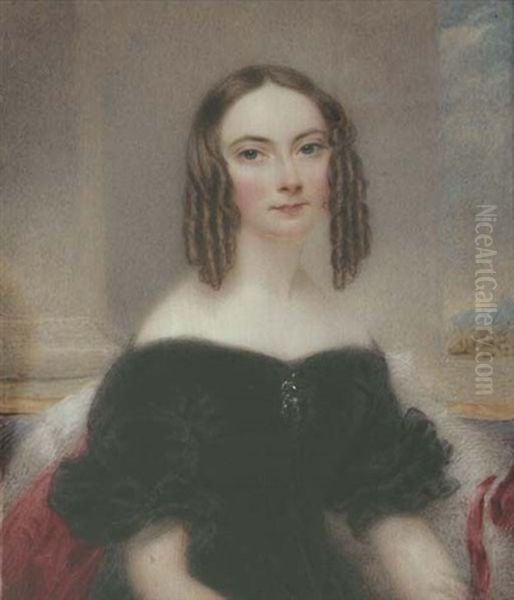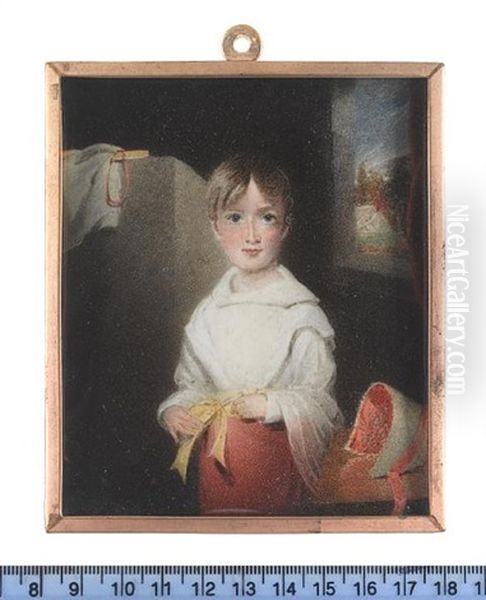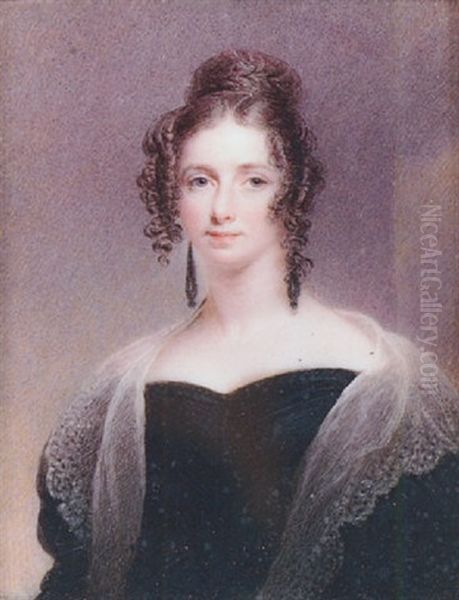Thomas Hargreaves (1775-1846) was a notable English miniature painter who established a significant reputation, particularly in Liverpool, during the late 18th and early 19th centuries. His career coincided with a flourishing period for portrait miniatures, a highly personal and portable art form, before the advent of photography began to eclipse its popularity. Beyond his artistic practice, Hargreaves also contributed to the theoretical discourse on colour, demonstrating an intellectual engagement with the materials and principles of his craft.
It is crucial at the outset to address a common point of confusion that sometimes arises. The Thomas Hargreaves who is the subject of this artistic exploration is distinct from James Hargreaves (c. 1720–1778), the inventor of the Spinning Jenny. While the initial information provided for this article erroneously attributed the invention of the Spinning Jenny to the painter Thomas Hargreaves, historical records unequivocally credit James Hargreaves, a weaver and carpenter from Lancashire, with this pivotal invention of the Industrial Revolution. The painter Thomas Hargreaves, born in 1775, would have been a mere child when James Hargreaves died in 1778, making any association with the invention of the Spinning Jenny chronologically and factually impossible. This article will focus solely on Thomas Hargreaves, the artist.
Early Life and Artistic Beginnings
Born in Liverpool in 1775, Thomas Hargreaves emerged during a vibrant era in British art. His early life and specific details of his initial artistic training are not extensively documented in easily accessible records, a commonality for many artists of the period who were not part of the dominant London elite from birth. However, it is known that he received a foundational education in art, which was essential for any aspiring painter.

A pivotal moment in Hargreaves's early career was his association with one of the leading portrait painters of the age, Sir Thomas Lawrence (1769-1830). Hargreaves worked as an assistant or apprentice to Lawrence for a period. This experience would have been invaluable, providing him with firsthand exposure to the techniques of a master portraitist, the workings of a successful studio, and access to a clientele that included the highest echelons of society. Lawrence, who would later become President of the Royal Academy, was renowned for his flamboyant style, his ability to capture the glamour and personality of his sitters, and his dazzling brushwork. Working under such a prominent figure undoubtedly shaped Hargreaves's skills and understanding of portraiture.
Despite the allure and opportunities of London, the epicenter of the British art world, Hargreaves eventually chose to return to his native Liverpool to establish his independent career. This decision may have been influenced by various factors, including a desire to be the leading miniaturist in a major provincial city rather than one among many in the capital, or perhaps familial ties and a fondness for his hometown.
The Art of the Miniature in Georgian England
To appreciate Thomas Hargreaves's contribution, it is important to understand the significance of miniature painting in his time. Portrait miniatures were small, intimate likenesses, typically painted in watercolour on ivory, vellum, or enamel. They served as keepsakes, tokens of affection, or diplomatic gifts, and were often set into lockets, brooches, or small frames. The late 18th and early 19th centuries are often considered the golden age of the British portrait miniature.
Artists specializing in this genre required exceptional skill in detailed brushwork, a keen eye for capturing a likeness on a small scale, and the ability to convey the sitter's character and status. The support, often a thin sheet of ivory, lent a particular luminosity to the watercolours. The technique involved stippling and hatching delicate layers of colour to achieve subtle gradations of tone and modelling.
Hargreaves practiced within this tradition, and his return to Liverpool around 1793 marked the beginning of a successful career as a miniature painter. Liverpool, as a burgeoning port city with a wealthy merchant class, provided a ready market for portraiture. Hargreaves quickly gained recognition for the quality and delicacy of his work.
Hargreaves's Artistic Style and Notable Works
Thomas Hargreaves's miniatures are characterized by their refined execution, sensitive portrayal of sitters, and competent handling of colour and light. While perhaps not possessing the dazzling flamboyance of some of his London contemporaries like Richard Cosway (1742-1821) or the psychological depth of John Smart (c. 1740-1811), Hargreaves produced consistently high-quality work that satisfied the tastes of his clientele. His portraits were valued for their accurate likenesses and elegant presentation.

Identifying specific, universally acclaimed "masterpieces" in the same vein as large-scale oil paintings can be challenging for miniaturists whose works were often private commissions. However, his oeuvre includes portraits of many prominent Liverpool families and individuals. For instance, he is known to have painted members of the Gladstone family, including a notable miniature of William Ewart Gladstone, the future Prime Minister, as a boy, and his father, Sir John Gladstone. He also painted a miniature of the renowned engineer James Watt. These commissions underscore his standing and the esteem in which he was held.
His works were regularly exhibited, notably at the Royal Academy in London between 1798 and 1831, and also at the Liverpool Academy of Arts, of which he was a founding member in 1810 and later served as its president. Exhibition at the Royal Academy was a significant mark of professional recognition, allowing provincial artists to showcase their talents to a national audience.
The provided information mentions "Byxbee Park" as a representative work of a "George Hargreaves," described as a landscape architect. It is essential to clarify that this George Hargreaves, associated with contemporary landscape architecture in California, is an entirely different individual from a different era and field, and has no connection to the 18th/19th-century miniature painter Thomas Hargreaves or his direct artistic lineage. Thomas Hargreaves's representative works are his portrait miniatures.
"Observations on Colours": A Foray into Theory
Beyond his practical skills as a painter, Thomas Hargreaves demonstrated an intellectual curiosity about the foundational principles of his art, particularly concerning colour. In 1813, he published a paper or treatise titled "Observations on Colours, as applicable to the Purposes of the Artist." This publication indicates his desire to contribute to the theoretical understanding of colour, a topic of considerable interest to artists and scientists throughout the 18th and 19th centuries.
In this work, Hargreaves discussed his system based on three primary colours: red, yellow, and blue. He elaborated on how these primaries could be mixed to produce secondary and tertiary colours, and how intermediate shades could be achieved through "dots and lines of connection." This practical approach, linking colour mixing to the artist's technique, reflects his experience as a practitioner. He also noted that pure white could only be produced by light itself, while grey, in terms of pigments, required the mixing of material colours.

His observations extended to the natural world, suggesting that artists could learn about subtle colour variations by studying nature. For example, he linked yellow with orange and green, implying an understanding of colour relationships and harmonies. This engagement with colour theory places Hargreaves within a broader tradition of artists and thinkers who sought to codify and understand the principles of colour, from the scientific investigations of Sir Isaac Newton (1643-1727) to the more phenomenological approaches of Johann Wolfgang von Goethe (1749-1832) whose Theory of Colours was published in 1810, and later, the influential work of Michel Eugène Chevreul (1786-1889) on simultaneous contrast. While Hargreaves's paper may not have had the far-reaching impact of these seminal works, it signifies his thoughtful approach to his profession and his contribution to the artistic discourse of his time.
Contemporaries and the Artistic Milieu
Thomas Hargreaves operated within a rich artistic landscape. In the field of miniature painting, his contemporaries included some of the most celebrated names in British art. Richard Cosway was perhaps the most fashionable miniaturist of the Regency era, known for his elegant and somewhat idealized portraits. George Engleheart (1750-1829) was another highly prolific and successful miniaturist, renowned for the sensitivity and characterization in his work. Andrew Robertson (1777-1845), a Scot who worked primarily in London, was a key figure in elevating the status of miniature painting and was known for his larger, more robust miniatures. Samuel Shelley (c. 1750-1808) was also a prominent miniaturist and watercolour painter, often depicting mythological and literary scenes in addition to portraits. Ozias Humphry (1742-1810) was another significant figure who, like Hargreaves, also worked in pastels and oils.
Beyond miniaturists, the broader portraiture scene was dominated by figures like Sir Thomas Lawrence, Hargreaves's former master. Other leading portraitists of the era included Sir Henry Raeburn (1756-1823) in Scotland, known for his strong, characterful portraits, and John Hoppner (1758-1810), a rival to Lawrence for royal and aristocratic patronage. The towering figures of the previous generation, Sir Joshua Reynolds (1723-1792) and Thomas Gainsborough (1727-1788), had established a powerful tradition of British portraiture that continued to influence subsequent artists. George Romney (1734-1802), though slightly earlier, was also a major force in portrait painting.
The establishment of the Liverpool Academy of Arts in 1810, with Hargreaves as a founding member, signifies the growing cultural ambition of provincial cities. Such institutions aimed to promote the arts, provide training, and offer exhibition opportunities outside London. Hargreaves's involvement, including his presidency, highlights his respected position within the Liverpool artistic community. He, along with artists like Samuel Williamson (1792-1840), a Liverpool marine painter, and Thomas Sword Good (1789-1872), known for his genre scenes, contributed to the regional artistic vibrancy.
Personal Life and Family
The information provided regarding Thomas Hargreaves's personal life presents some chronological inconsistencies that need careful handling. One source states that a "Thomas Hargreaves" married Camilla Macfarlane, daughter of Mr. W. M. Macfarlane, in 1894, and that they had a daughter, with both wife and daughter predeceasing him. Given that the painter Thomas Hargreaves died in 1846, this marriage in 1894 clearly refers to a different individual, possibly a descendant or simply someone else with the same common name. It is a biographical detail that cannot be attributed to the miniaturist (1775-1846).
What is known about the painter Thomas Hargreaves (1775-1846) is that he had a family, and art ran in it. He had at least two sons who also became artists: Thomas Hargreaves Jr. (sometimes listed as Thomas Hargreaves the Younger) and George Hargreaves. Both sons followed in their father's footsteps to some extent, also practicing as painters, though they did not achieve the same level of prominence as their father. This continuation of artistic practice within families was not uncommon during this period. The shared profession could foster a supportive environment for learning and development, as well as a network for commissions.
The earlier mention of a "Charles Roger Hargreaves" in the provided source material, described as a British author and illustrator of children's literature (creator of the "Mr. Men" and "Little Miss" series), also refers to an entirely different person. Charles Roger Hargreaves (1935-1988) belongs to a much later period and a different field of creative endeavor. It is important to keep these identities distinct to avoid confusion. The focus here remains on Thomas Hargreaves, the 18th and 19th-century miniaturist.
Later Career, Legacy, and Historical Evaluation
Thomas Hargreaves continued to practice as a miniature painter in Liverpool throughout the first few decades of the 19th century. He maintained a solid reputation for his skillful and pleasing likenesses. His contributions to the Liverpool Academy of Arts, including his role as president, demonstrate his commitment to fostering a local artistic culture.
The art of miniature painting, however, began to face a significant challenge in the later part of Hargreaves's career and especially after his death. The invention and popularization of photography, particularly the daguerreotype from the late 1830s onwards, offered a new, quicker, and often cheaper way to obtain a personal likeness. While miniature painting continued, its dominance as the primary means of small-scale portraiture waned.
In art historical evaluations, Thomas Hargreaves is regarded as a competent and accomplished miniaturist who made a significant contribution to the art scene in Liverpool. He may not be placed in the very first rank of British miniaturists alongside figures like Nicholas Hilliard (c. 1547-1619) from an earlier era, or his own contemporaries like Richard Cosway or John Smart, whose works often command higher prices and greater scholarly attention today. However, his skill was undeniable, and his portraits provide valuable historical records of the personalities of his time, particularly within the Liverpool community.
His foray into colour theory, with his "Observations on Colours," adds another dimension to his profile. It shows him as an artist who was not merely a craftsman but also a thinker, engaged with the intellectual currents related to his art. While his theories may not have revolutionized the field, they represent a sincere attempt to understand and articulate the principles he employed daily in his studio.
Thomas Hargreaves died in Liverpool in 1846. His legacy resides in the numerous delicate portraits he created, which continue to be appreciated for their artistry and as historical documents. He represents a significant tier of professional artists who sustained a high level of craftsmanship and contributed to the cultural life of Britain beyond the confines of the capital. His work, and that of his contemporaries like William Wood (1769-1810) and Andrew Plimer (1763-1837), who also produced a vast number of fine miniatures, collectively define the character and achievements of British miniature painting during its zenith.
Conclusion
Thomas Hargreaves of Liverpool (1775-1846) stands as a noteworthy figure in the history of British miniature painting. Apprenticed under the celebrated Sir Thomas Lawrence, he developed a refined skill that he brought back to his native city, establishing a successful career and becoming a pillar of its artistic community. His miniatures, characterized by their delicate execution and faithful likenesses, captured the visages of many prominent individuals of his day.
Beyond his prolific output as a painter, Hargreaves's intellectual engagement with his craft is evidenced by his 1813 publication on colour theory, offering insights into the practical and theoretical concerns of an early 19th-century artist. While navigating a field populated by such luminaries as Cosway, Engleheart, and Robertson, Hargreaves carved out a respected niche, contributing significantly to the cultural fabric of Liverpool and the broader tradition of British portraiture. His life and work offer a valuable window into the world of art, patronage, and artistic discourse during a transformative period in British history, before the art of the miniature gave way to the era of the photograph. His legacy is that of a skilled artist, a thoughtful observer, and a dedicated contributor to his profession.